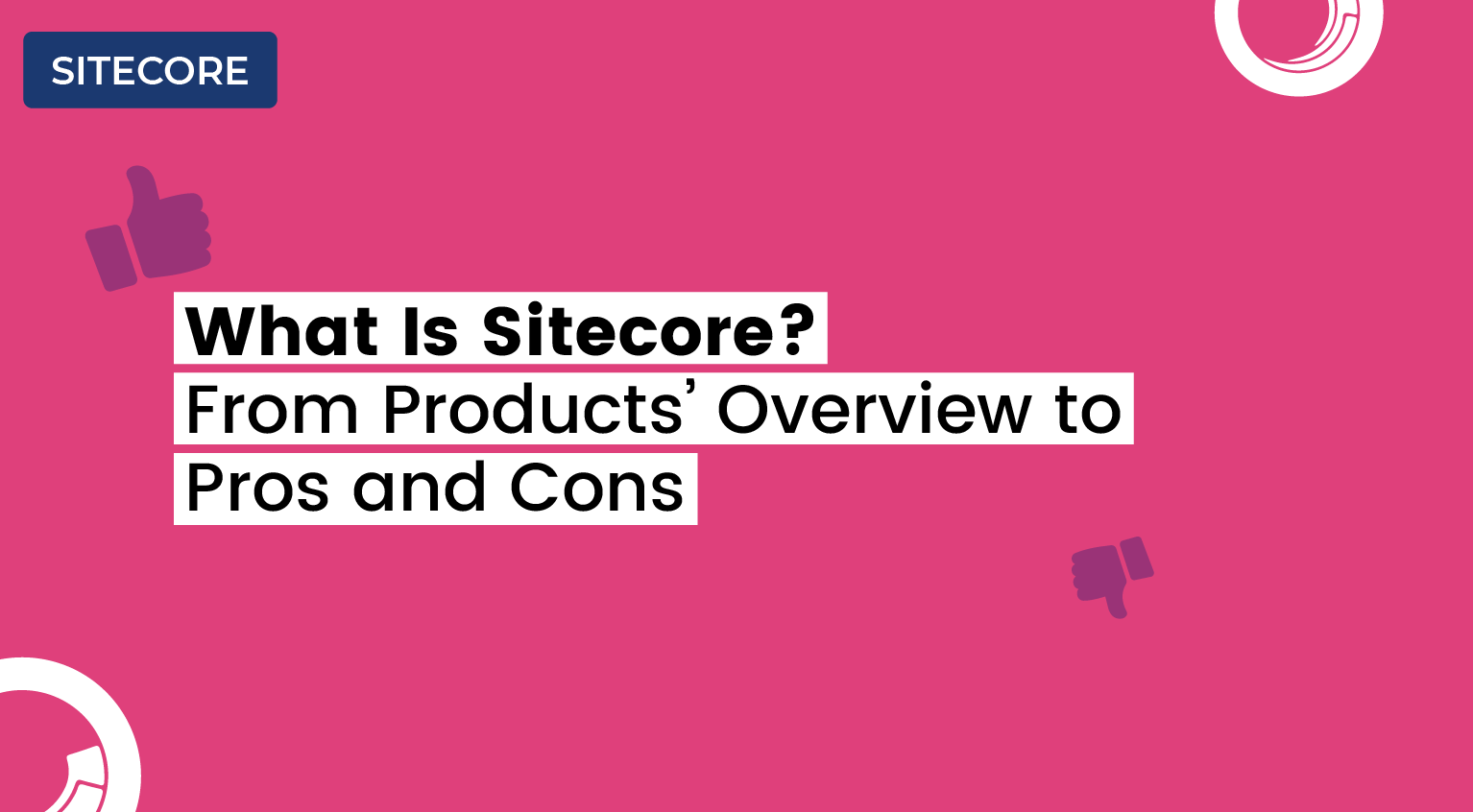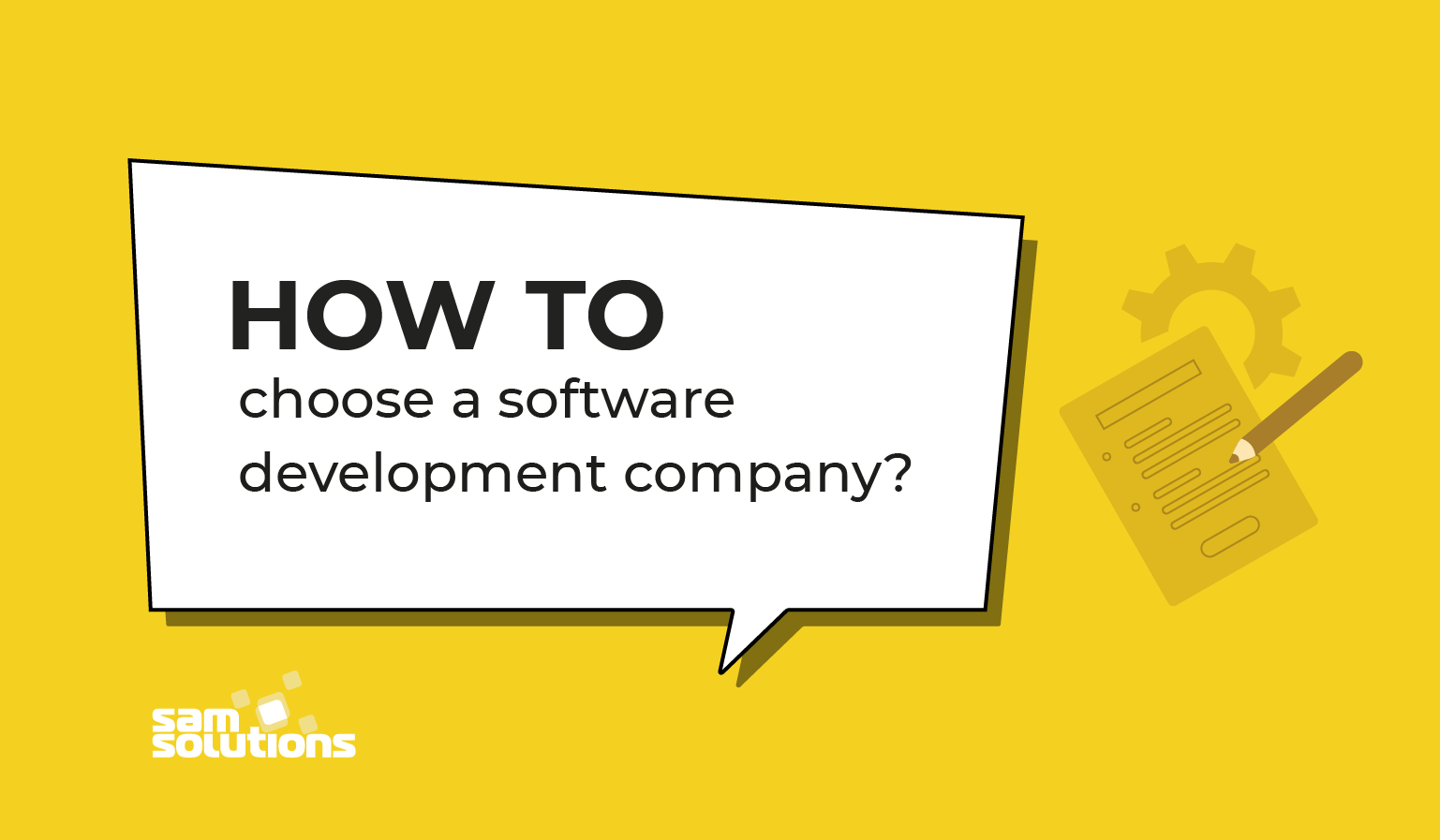In 2018, Forbes predicted that by the end of 2020, nearly 84% of all business workloads would take place in the cloud. Cisco took the idea a step further, predicting that 94% of business workloads would be cloud-based by 2022.
At the time, while most IT professionals surveyed agreed that cloud adoption was advancing at a rapid pace, relatively few subscribed to the idea that such a widespread adoption would occur so quickly.
With the recent shift to remote work front-of-mind in the business world, those numbers aren’t quite so radical; more businesses are utilizing cloud computing than ever before.
In fact, the four most prominent cloud deployment models – public, private, hybrid, and community cloud models – continue to increase in popularity, while distributed cloud types like poly clouds, multi-clouds, and other distributed models, serve growing amounts of smaller niches.
Is cloud computing right for you? If so, which deployment model is best? What are some reasons why cloud computing is important for business growth?
Before diving into the advantages and disadvantages of cloud deployment models, it’s important to build an understanding of what a cloud deployment model is.
What Is a Cloud Deployment Model?

Simply put, a cloud deployment model describes the specific ownership, management, and workload parameters of the cloud environment.
The deployment model not only determines the specific infrastructure and features available, but also sets parameters for access, infrastructure ownership, and how much storage space is available.
Which model you choose will ultimately describe who owns and manages the environment, as well as the particular workload specifications it can handle.
So, in order to identify the cloud deployment model that will help your business overcome its current challenges, you’ll need to determine which option best suits your business regarding both control and location.
You should carefully consider the pros and cons of each model as it applies to:
- Resources. Your business’s resources for handling infrastructure.
- Computing. Your unique computing requirements.
- Networking. Your business’s networking requirements.
- Storage. Your storage needs.
- Goals. The ultimate goals of your business.
With these considerations in mind, let’s explore the advantages and disadvantages of cloud deployment models.
Cloud Deployment Model #1 – Public Cloud
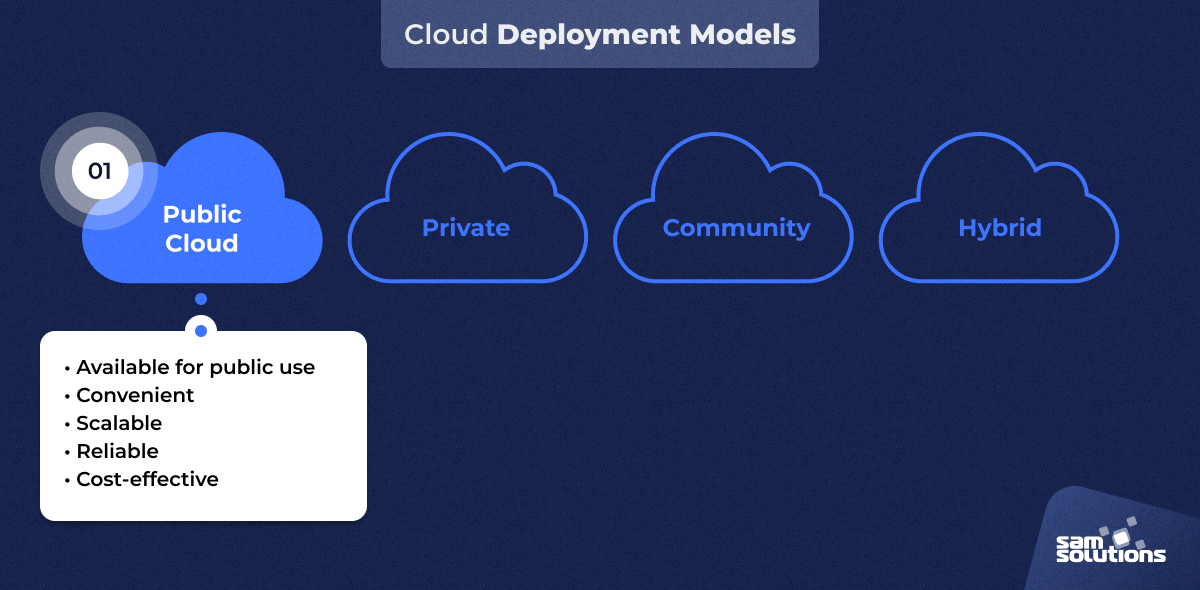
As you may have guessed, the public cloud deployment model describes clouds available for public use. A third party – often a well-known service provider – constructs and manages the infrastructure involved. The third party then allows other businesses and public users to create and store data on its servers.
With a public cloud deployment model, although the infrastructure is used by multiple individuals and businesses, the service provider remains responsible for its management and upkeep of its resources; as a result, all hardware is housed at the service provider’s location.
In turn, you can determine resource use and scale if needs fluctuate without worrying about maintaining equipment or altering a contract. Depending on the service agreement, the service provider may offer this service free or charge a fee based on the number of resources you use.
Currently, public clouds are the most popular form of cloud deployment model, used either alone or in combination with another deployment model, by 91% of businesses to handle 41% of the workload.
Amazon’s Elastic Compute Cloud (EC2) was rated the top public cloud service provider for 2020 and exists as an Infrastructure-as-a-Service (IaaS) model as a part of the larger Amazon Web Services (AWS) cloud solutions platform.
Microsoft Azure, Google App Engine, Google Compute Engine (a part of Google’s Cloud Platform), IBM Cloud, and Salesforce Heroku are other popular options.
Advantages of a Public Cloud Deployment Model
Public cloud models are popular for a reason – they offer several advantages for users like you, including:
- Convenience. When you choose a public cloud deployment model, the service provider is responsible for infrastructure setup and use, as well as the vast majority of the everyday concerns of its management. In short, you won’t need to worry about developing, maintaining, or upgrading your software – the service provider will do it for you.
- Reliability. Unlike on-site infrastructure owned by a small enterprise, third-party service providers often have a large network of servers at your disposal, ensuring 24/7 operation and practically eliminating downtime.
- Scalability. Most public cloud service providers allow you to easily scale your usage up or down as your needs require.
Cost-effectiveness. Due to advanced scalability and reliability, you’ll only use as many resources as you need, reducing your cost and eliminating costly downtimes. In addition, there’s no need to invest in your own hardware.
Disadvantages of a Public Cloud Deployment Model
While public cloud models work well for many businesses, there are a few disadvantages to this cloud deployment model, such as:
- Potential security issues. Perhaps the number one concern regarding public cloud models is the data security and privacy issues that arise when a public third-party controls data storage. While users can easily access their own data, concerns remain regarding who else has access and where that particular data is kept.
- Simplicity. Many public cloud service providers rely on scalability and offer only the most basic service plans. While simple service agreements are beneficial for many users, if you require more customized service plans that fit your business, it may be difficult to find one to meet your needs.
- Potential diminished reliability. Reliability is often considered a strong suit of a public cloud model; however, there is still a potential for service outages with such wide-ranging networks.
Cloud Deployment Model #2 – Private Cloud
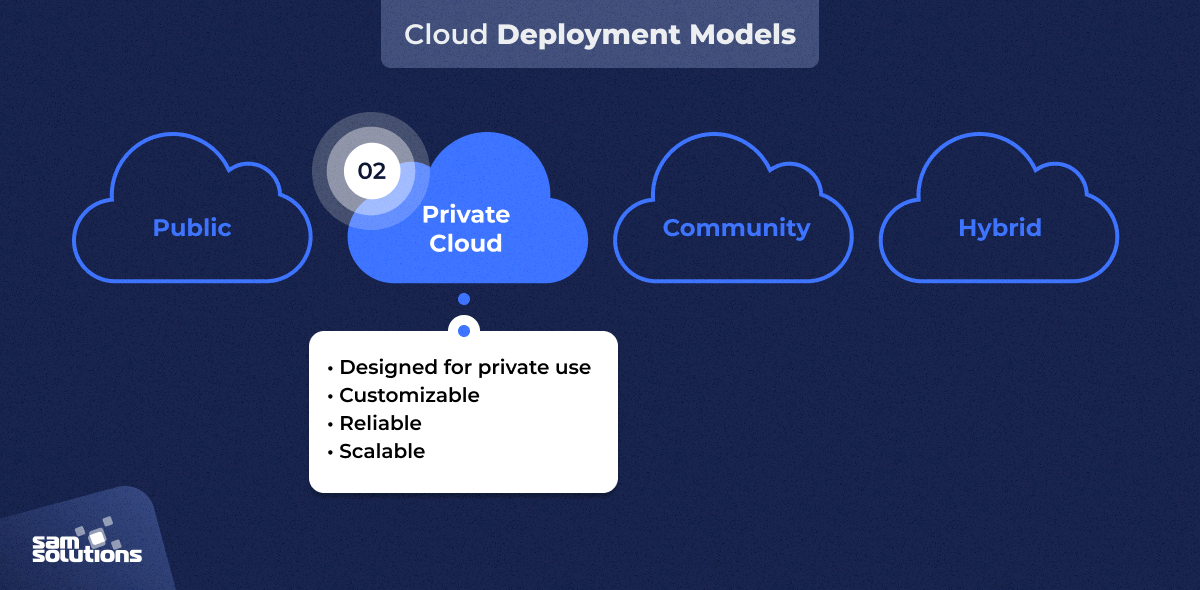
While public and private cloud models can seem, on the surface, to be drastically different deployment models, the truth is that they are actually very similar. Their architectures are constructed in a nearly identical fashion and incorporate cloud resources in the same way.
However, while a public cloud model provides infrastructure and resources for the general public to use, a private cloud model is accessible only by one business.
Also known as corporate clouds or internal clouds, private clouds can be located on the premises of the business that owns them or can be hosted by a third-party company.
Depending on which model you choose, you may be responsible for the maintenance and upkeep of the physical servers. However, regardless of the infrastructure’s location, private cloud utilities hardware and software are only accessible by its owner, functioning on a designated private network.
Private cloud models are increasing in popularity, coming in second after public models. Today, 72% of businesses use a private cloud, either alone or as part of a solution with one or more other cloud deployment models.
As a result, many of the most popular public cloud service providers – including Amazon and IBM as well as other providers like Dell and Cisco – offer popular private cloud models, too.
Advantages of a Private Cloud Deployment Model
Most of the benefits of a private cloud deployment model directly result from your business’s ability to control various aspects on your own. Benefits include:
- Security and privacy. Unlike public cloud models, private clouds clearly define who has access to important data and private information and prevent public access. As a result, data breaches are minimum, and private users can rest assured outside entities do not have access to their data.
- Customization. Compared to public cloud models, private clouds offer superior customization and uniquely designed solutions tailored to an individual business’s needs. You can determine your requirements and build or scale a private cloud to suit them with relative ease.
- Reliability. While public cloud service plans can be scaled up or down fairly easily, private clouds are scaled by adding additional tiers of hardware used only by your business. This dedicated infrastructure offers ideal reliability since it is only available to dedicated users.
Disadvantages of a Private Cloud Deployment Model
While there are relatively few disadvantages of a private cloud in general, it may come with a higher initial cost than other types of cloud deployment.
Between the hardware, software, and training necessary to establish a private cloud – as well as the staff required to initiate it – expect to expend additional resources during the early stages.
However, if you do everything well initially and utilize the proper experts necessary for optimal private cloud development, you’ll have a smoothly operating cloud that can solve issues with security, privacy, reliability and customization. All this while saving you money in the future.
Cloud Deployment Model #3 – Community Cloud
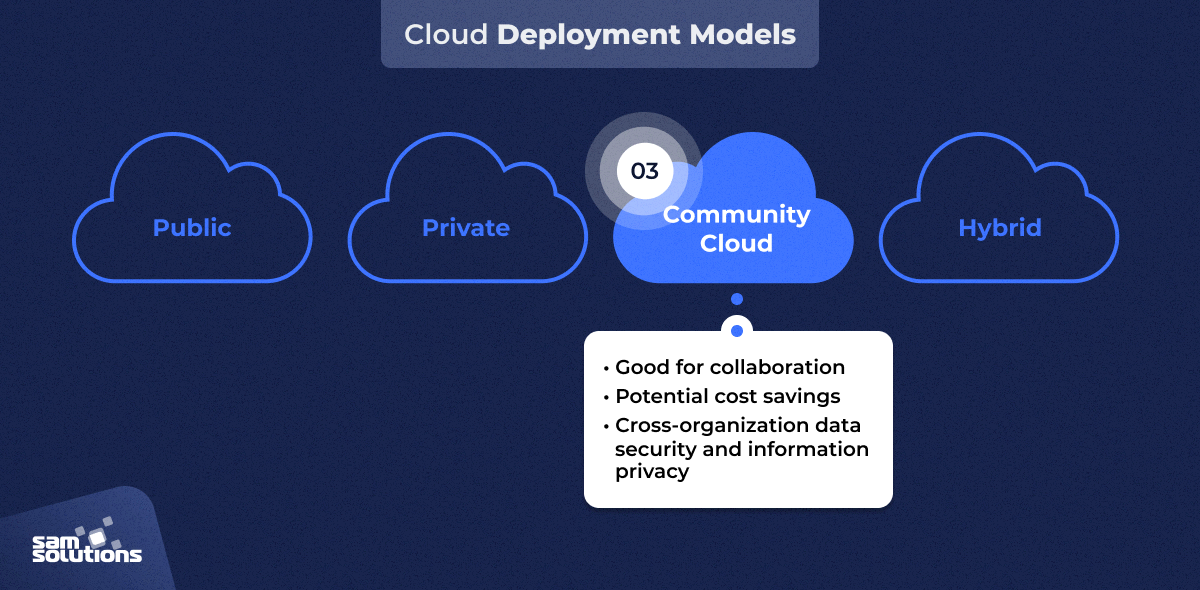
While community cloud deployment models may sound like they are modeled after public clouds, they are actually much more similar to private cloud models. However, although the infrastructures are organized much the same way, there is one key difference – the approved user base.
In a private cloud model, one business owns and utilizes the infrastructure; in a community cloud model, one organization owns the private cloud infrastructure and multiple businesses with similar characteristics share its resources.
These community, or multi-tenant, cloud models work best if each participating organization has similar security, privacy, storage, and other performance requirements. If this is the case, organizations are able to capture the efficiency benefits that come with sharing resources under the same parameters.
In addition, partners can participate in joint projects, achieve enhanced project development, and share the costs and tasks of implementation and maintenance.
Advantages of a Community Cloud Deployment Model
As mentioned previously, if you are able to find multiple, similar organizations with the same security, privacy, and performance parameters, you can experience multiple benefits of a community cloud, such as:
- Cost savings. Once established, you can pool resources with other organizations and split the cost of maintenance and upkeep.
- Security and privacy. Similar to a private cloud deployment model, with very limited access to user information, community cloud models offer enhanced data security and information privacy.
- Collaboration. With the availability of data sharing between organizations on the community cloud, users can collaborate and undertake joint projects.
Disadvantages of a Community Cloud Deployment Model
While the above advantages of a community cloud deployment model are significant, the model’s major downfall is its reliance on finding numerous other organizations that share your requirements. As a result, disadvantages include:
- Rarity. Community cloud deployment is still less common than other deployment models because it is necessary to locate other organizations with similar requirements.
- Relatively high cost. Compared to the public cloud model, community cloud models have a high initial cost and can be somewhat costly to maintain, depending on the number of partners involved.
- Limited bandwidth and storage. With multiple organizations sharing the same resources, bandwidth, and storage capacity can be a concern.
Cloud Deployment Model #4 – Hybrid Cloud
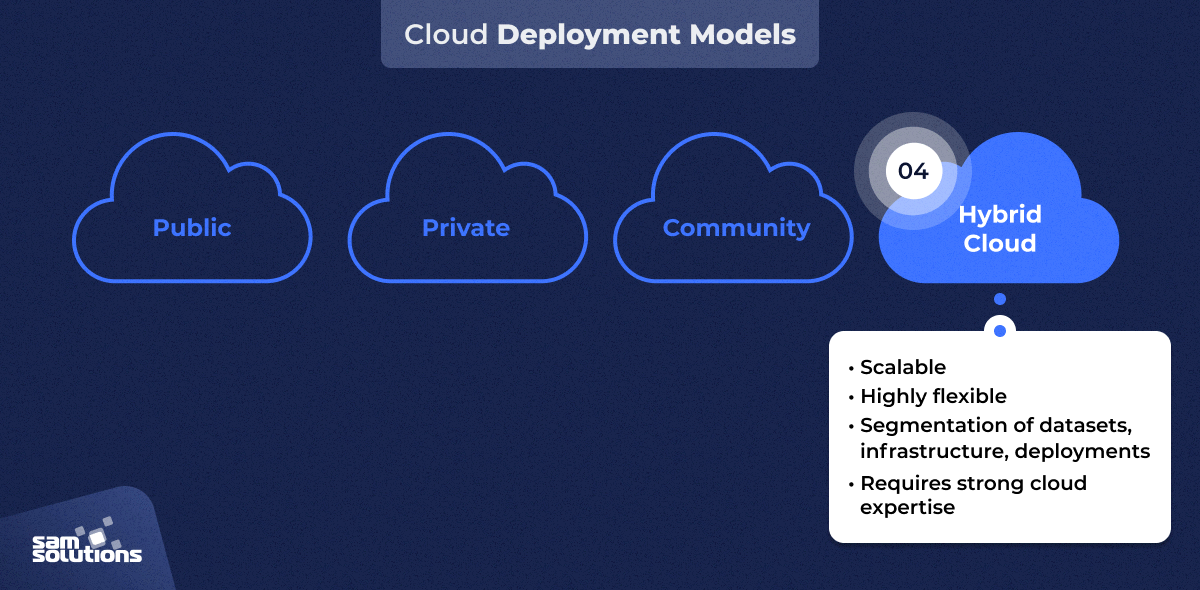
In any other sector, a hybrid model selects the best aspects of each traditional model and fuses them to improve performance, economic sustainability, flexibility, and more. Hybrid cloud models achieve exactly this goal by melding elements of public, private, and community cloud models.
Best of all, the aspects of each cloud model you use are customizable based on your business and its unique needs.
69% of businesses that utilize cloud infrastructure choose a hybrid model that consists of public, private, and community cloud model qualities. If your workflow consists of multiple, complex datasets that are a mix of hypersensitive private user data and general data available to the public, you may benefit from implementing a hybrid cloud approach.
This allows you to focus your financial resources on your most crucial data and processes while saving resources on data approved for public use.
Advantages of a Hybrid Cloud Deployment
As you may have guessed, the advantages of hybrid cloud deployment are shared with some of the other deployment models. Advantages include:
- Security and privacy. Much like a private cloud, you can ensure your data remains secure when you are the only organization that uses the private portion of your infrastructure.
- Potential cost savings. The ability to spend more to safeguard your most critical assets while scaling back on your more general data can save you money long-term.
- Superior flexibility and scalability. While both public and private cloud deployments are flexible and scalable in their own ways, hybrid cloud deployments allow you to benefit from both flexibilities in a way that makes sense for your business’s unique challenges.
Disadvantages of Hybrid Cloud Deployment
As flexible, scalable, and secure as hybrid cloud models can be, they are the most advantageous for businesses that would benefit from splitting data into sensitive and non-sensitive categories.
Implementation can be complex and is usually best handled by a service partner with extensive experience in cloud deployments.
Advantages and Disadvantages of Cloud Deployment Models: Comparison Table
Comparing the advantages and disadvantages of cloud deployment models can be a little complex. Here, we’ve compiled decision essentials into an easy-to-use table that provides a visible comparison between the four major models:
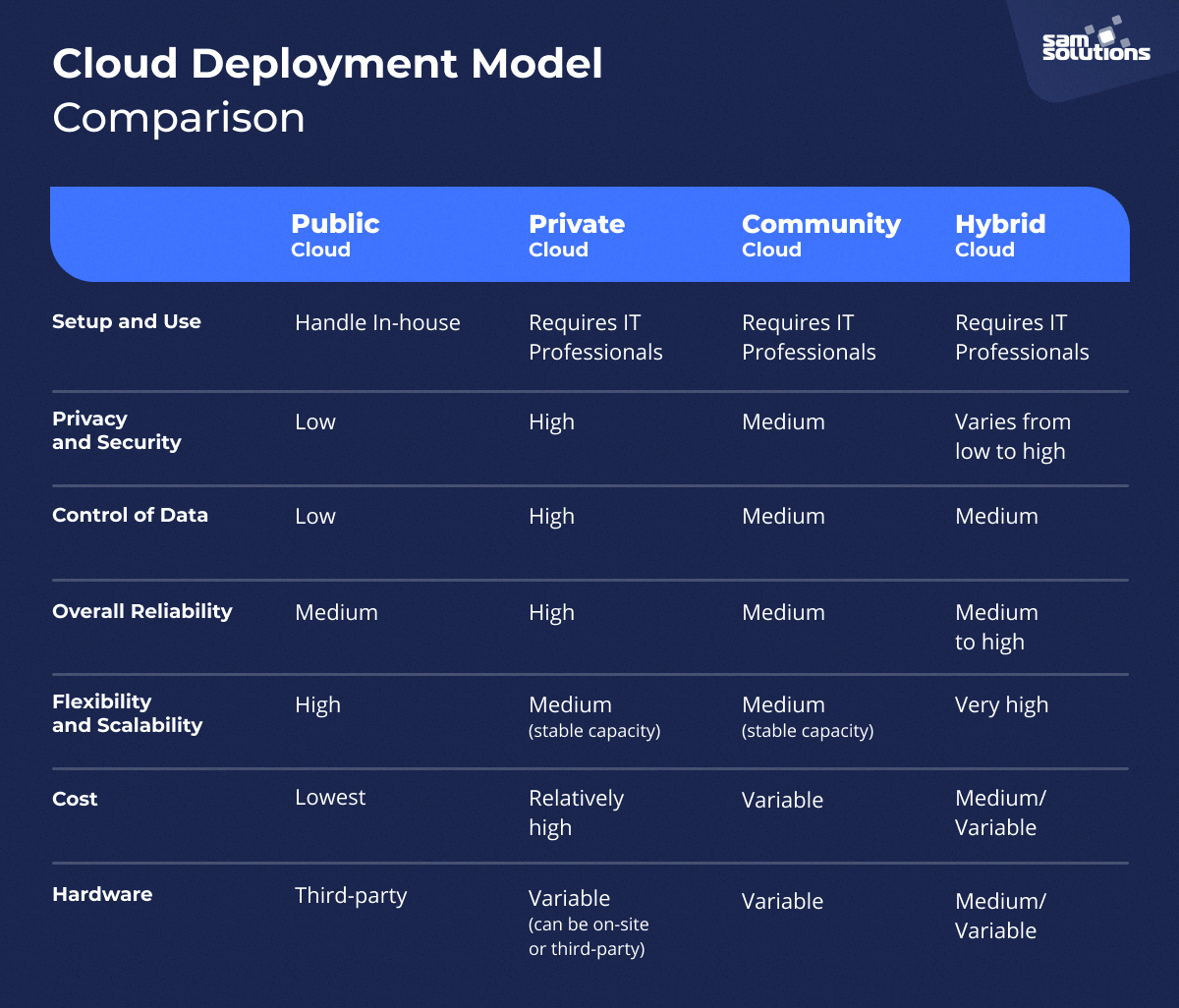
Your cloud deployment model choice is a crucial decision for your organization and requires careful consideration of multiple factors.
You must determine your business’s goals, security requirements, storage needs, hardware preferences, future scalability needs, and more – and then determine whether the advantages and disadvantages of each model align with your unique requirements.
We strongly recommend undertaking this challenging task with the help of a professional cloud solutions partner.
While comparing the advantages and disadvantages of cloud deployment models is beneficial, you should consult with an experienced cloud solutions partner to determine specific needs.
Why Choose SaM Solutions?
As an enterprise-level partner with numerous cross-technology solutions experts, SaM Solutions has extensive experience in cloud deployments. Our expert team can help you assess your needs and choose the model that provides the best fit for your company.
Once your cloud deployment model is in place, we’ll ensure that it continues to meet your security and risk-management requirements, exceed your performance expectations, and leverage your resources to reach your goals.
SaM Solutions has utilized our experience and diverse skill set to benefit a number of multinational corporations such as SAP, Siemens, Telekom Slovenije, the Instant Group, Fujitsu, and many, many more.
We are a Gold Microsoft Partner as well as a SAP Silver Partner certified to offer Oracle FPX, Toradex, and Coveo services. If you’d like more information about the best cloud deployment model for your organization, reach out to SaM Solutions today.
Resources:
- https://newsroom.cisco.com/press-release-content?type=webcontent&articleId=1908858
- https://www.forbes.com/sites/louiscolumbus/2018/01/07/83-of-enterprise-workloads-will-be-in-the-cloud-by-2020/#138c4a486261
